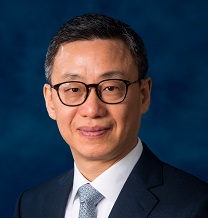The Year of the Ox is around the corner, and we have reasons to be slightly more bullish on the outlook of this year. With the development and adoption of COVID-19 vaccines, we look forward to a year of recovery, starting from the world gradually but steadily stepping out of the health crisis that has swept over the globe. In the economic and financial landscape, three themes, among others, will continue to affect our global markets.
First and foremost, it is the pace at which world economy can recover and revive. Undoubtedly, with distinct economic composition and having taken different policy approaches, each economy will take its own path navigating the recovery cycle. The Asian and Chinese economies, fortunately for us, have shown considerable resilience through the crisis and are now generally believed to be among the first to be back on the growth trajectory. According to the International Monetary Fund's latest forecast, Mainland China's economy will achieve an economic expansion of 8.1% this year.1
Secondly, although geopolitical tension may recede somewhat, it will most likely persist as the world’s two largest economies – the U.S. and Mainland China – continue to find the new equilibrium in their highly structurally intertwined economic relationship. For the financial sector, the spill-over effects will be lasting, as exemplified by the recent back-and-forth of the New York Stock Exchange on halting the trading of three Mainland Chinese telecom providers.
Thirdly – and perhaps most importantly – technological innovation will continue to catalyse advancements in the way we shop, communicate, do business, manage finances and receive healthcare, and along the way gradually yet fundamentally change our way of living.
Amidst these new patterns, the facilitating role of an international financial centre in allocating resources and steering economic growth is ever more prominent – a role that Hong Kong, with its world-class financing infrastructure, has been playing successfully for decades.
In the very atypical 2020, Hong Kong’s IPO market remained very resilient as our Main Board welcomed 146 new listings, raising HK$396 billion2 in total and recording a ten-year high. Thanks to the forward-looking reform of the listing regime in 2018 and active participation of market players, the local equity market has undergone a structural transformation and successfully established itself as an optimal listing venue for new economy companies. These companies accounted for nearly 60% of the total capital raised in Hong Kong since the implementation of the new listing rules, either through primary or secondary routes. In the same vein, Hong Kong has become the second largest biotechnology financing centre in the world in just a few years, with 51 healthcare and biotechnology companies listed on the Main Board since the new listing rules came into effect.
Notwithstanding our own achievements, other major international markets have also stepped up their efforts in increasing appeal to pre-listing companies and investors, some through providing higher flexibility through disclosure-based IPO vetting, adopting faster processing time, and having more acceptance of modern corporate practices such as corporate weighted voting rights (CWVR) arrangement.
To fortify our leading position and to stay competitive in the global fund-raising arena, we are not resting on our laurels in the journey of optimising our regulatory regimes and, indeed, various initiatives have been undertaken by the Government, regulators as well as and market players. For example, HKEx rolled out a consultation last year with regards to introducing CWVR to our listing regime, which would broaden the listed company base.3 While a further consultation will be conducted in due course to give the market more time to discuss the regulatory regime applicable to CWVR, it is very encouraging to note the HKEx has extended its grandfathering arrangements for certain innovative companies with a CWVR structure and strong business focus on Greater China.
Likewise, we at the FSDC are sparing no efforts to contribute to the betterment of our markets. Having had most of the policy recommendations put forward in our Nov 2018 paper “Environmental, Social and Governance (ESG) Strategy for Hong Kong”4 adopted by the Government and Regulators, FSDC is now studying the availability of ESG and FinTech related talent. We are also conducting researches on further development of the REITs market as well as the asset and wealth management industry. These topics are very dear to our heart, and we will make our work available as early as practicable.
Separately, as we carry out research on global capital market development, we found that listing of special purpose acquisition companies (SPACs) has gained huge popularity in the U.S. in 2020, having raised US$82 billion in 2020, representing a sixfold increase from the previous record high in 2019.5 While the proliferation of SPAC listings may have its own risks, we believe it is worth studying with caution, given the rising prevalence.
As we approach the Year of the Ox, we at the FSDC wish you all prosperity and good health. We look forward to working closely with policymakers and market participants to continuously create new momentum in our resilient and vibrant financial markets.
1 The International Monetary Fund, https://www.imf.org/en/Publications/WEO/Issues/2021/01/26/2021-world-economic-outlook-update
2 HKEx, New Listing Information, https://www2.hkexnews.hk/new-listings/new-listing-information/main-board?sc_lang=en
3 As of now, the only way companies with CWVR to list in Hong Kong is still through a secondary listing via a grandfathering route
4 FSDC Paper No. 36, Nov 2018, https://www.fsdc.org.hk/en/press-publications/environmental-social-and-governance-esg-strategy-for-hong-kong
5 The Wall Street Journal, https://www.wsj.com/articles/2020-spac-boom-lifted-wall-streets-biggest-banks-11609842601
